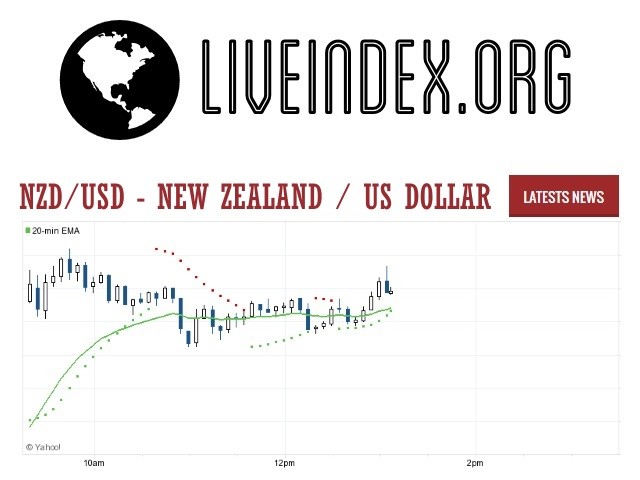| Symbol | Last | Change | % | High | Low |
|---|---|---|---|---|---|
| NZD / USD | 0.5805 | +0.0000 | +0.00% | 0.0000 | 0.0000 |
| Close | GMT Time : Sat Dec 13 2025 04:01 | ||||
NZD/USD : Intraday Live Chart
NZD/USD : Technical Signal Buy & Sell
| 5 Min Signal | 1 Hour Signal | 1 Day Signal |
|---|---|---|
| Sell | Sell | Buy |
NZD/USD : Moving Averages
| Period | MA 20 | MA 50 | MA 100 |
|---|---|---|---|
| 5 Minutes | 0.58 | 0.58 | 0.58 |
| 1 Hour | 0.58 | 0.58 | 0.58 |
| 1 Day | 0.57 | 0.57 | 0.58 |
| 1 Week | 0.58 | 0.58 | 0.60 |
NZD/USD : Technical Resistance Level
| Resistance 1 - R1 | Resistance 2 - R2 | Resistance 3 - r3 |
|---|---|---|
| 0.0000 | 0.0000 | 0.0000 |
NZD/USD : Technical Support Level
| Support 1 - S1 | Support 2 - S2 | Support 3 - S3 |
|---|---|---|
| 0.0000 | 0.0000 | 0.0000 |
NZD/USD : Periodical High, Low & Average
| Period | High Change from Last | Low Change from Last | Average Change from Last |
|---|---|---|---|
| 1 Week | 0.5817 -0.0012 | 0.0000 +0.5805 | 0.5789 +0.0016 |
| 1 Month | 0.5817 -0.0012 | 0.0000 +0.5805 | 0.5706 +0.0099 |
| 3 Month | 0.5990 -0.0185 | 0.0000 +0.5805 | 0.5748 +0.0057 |
| 6 Month | 0.6101 -0.0296 | 0.0000 +0.5805 | 0.5854 -0.0049 |
| 1 Year | 0.6101 -0.0296 | 0.0000 +0.5805 | 0.5828 -0.0023 |
NZD/USD : Historical Chart
NZD to USD Exchange Rate: Commodity Correlation and Fed vs RBNZ Policy Driving Volatility
The NZD to USD exchange rate encapsulates the performance of a commodity-export-driven small economy (New Zealand) against the world’s dominant reserve currency (the US dollar). This pair is sensitive to shifts in global risk sentiment, interest rate differentials, and commodity cycles—especially dairy, meat, and wool, which are major New Zealand exports.
1990s: Structural Reforms and USD Dominance
In the 1990s:
NZD/USD mostly ranged between 0.50–0.70, with high volatility.
New Zealand was undergoing economic liberalization, removing subsidies and shifting to a market-based framework.
Meanwhile, the USD remained strong on the back of post-Cold War dominance and a booming US economy.
NZD appreciated during global growth cycles but remained vulnerable to external shocks, particularly from Asia-Pacific.
2000–2008: Commodity Boom Favors NZD
The early 2000s saw a strong NZD recovery:
NZD/USD climbed from ~0.39 in 2001 to ~0.80 by 2008.
This coincided with the global commodity supercycle, driven by Chinese demand and rising dairy prices.
The RBNZ kept rates high (6–8%) to manage inflation, drawing in capital flows.
The USD weakened during this period, weighed down by twin deficits and early signs of the US housing bubble.
2008–2012: Financial Crisis and Safe-Haven Flows
The 2008 global financial crisis reversed these gains:
NZD/USD plummeted to ~0.49 in late 2008, as risk aversion surged and investors fled to the safety of the dollar.
New Zealand entered a mild recession, and the RBNZ slashed rates rapidly.
The USD strengthened as the world’s reserve currency, despite domestic turmoil.
The pair rebounded gradually post-crisis but remained sensitive to Fed actions and commodity prices.
2013–2019: Fed Normalization vs RBNZ Divergence
This decade featured alternating strength:
NZD/USD fluctuated between 0.65 and 0.88, peaking in 2014.
While the RBNZ hiked briefly, the Fed began gradual rate normalization, supporting USD strength post-2016.
Weak dairy prices and soft inflation capped NZD upside.
Overall, the decade ended with the USD on top, but the NZD remained resilient due to strong economic fundamentals.
2020–2024: Pandemic Shock, Commodity Rebound, and Diverging Central Banks
A highly volatile era:
NZD/USD fell to 0.56 in March 2020 due to the COVID-19 panic.
It rebounded strongly as global stimulus, rising dairy exports, and RBNZ’s early rate hikes supported the kiwi.
By mid-2021, NZD/USD hit ~0.74, before retreating on Fed tightening expectations.
In 2023–24, the USD gained ground again as Fed rates peaked at 5.5%, while the RBNZ paused hikes around 5.5%.
The pair has since traded in a tight 0.59–0.63 range, influenced by shifting yield spreads and commodity demand.
April 2025 Snapshot: Dollar Reasserts Control
As of April 2025, NZD/USD trades near 0.605, reflecting:
A stronger USD as the Fed delays rate cuts amid sticky US inflation.
Weaker global demand for New Zealand exports, especially as China’s growth slows.
NZD pressure from a potential RBNZ rate cut later this year.
The pair remains vulnerable to external shocks, especially if the Fed maintains a hawkish tone through Q2.
✅ Key
🟢 = NZD appreciated vs USD
❌ = NZD depreciated vs USD
⚠️ = Mixed or sideways movement
📊 NZD to USD Exchange Rate by Decade
| Decade | Avg. NZD/USD Rate (Approx) | Change vs. Previous Decade | Key Events |
|---|---|---|---|
| 1990s | 0.63 | ⚠️ Range-bound | NZ reforms, USD strength, Asian crisis |
| 2000s | 0.68 | 🟢 NZD gains | Commodity boom, USD weakness, high NZ rates |
| 2010s | 0.72 | ⚠️ Mixed | Fed hikes, NZ dairy volatility, global uncertainty |
| 2020s (till 2025) | 0.64 | ❌ NZD underperforms | Pandemic, Fed hawkish pivot, NZ export challenges |
While the NZD to USD exchange rate reflects a relatively minor economy against the world’s financial powerhouse, it serves as a proxy for global risk appetite and commodity market sentiment. With central bank divergence continuing into 2025, traders will closely watch Fed inflation rhetoric, China’s growth path, and New Zealand’s trade metrics to assess near-term direction.
NZD/USD - New Zealand Dollar / US Dollar Currency Rate

Live Price of NZD/USD. NZD/USD Live Chart, Intraday & Historical Live Chart, Buy Sell Signal, NZD/USD News, NZD/USD Averages, Returns & Historical Data
» NZD/USD
» NZD/USD Real Time Quotes
» NZD/USD Live Chart
» NZD/USD Intraday Chart
» NZD/USD Historical Chart
» NZD/USD Buy Sell Signal
» NZD/USD News
» NZD/USD Videos
» NZD/USD Averages
» NZD/USD Currency Pair
» NZD/USD Historical Data








